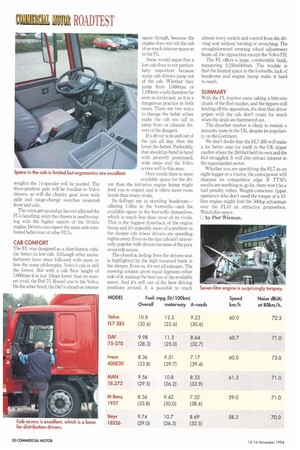weights the 14-speeder will be needed. The three-position gate will
Page 52

If you've noticed an error in this article please click here to report it so we can fix it.
be familiar to Volvo drivers, as will the chunky gear lever with split and range-change switches mounted front and side.
The extra get up and go has not affected the FL's handling, since the chassis is used to coping with the higher ouputs of the 10-litre engine. Drivers can expect the same safe surefooted behaviour of other FL7s.
CAB COMFORT
The FL was designed as a distribution vehicle; hence its low cab. Although other manufacturers have since followed with more or less the same philosophy, Volvo's cab is still the lowest. But with a cab floor height of 1,060mm it is just lOmm lower than its nearest rival, the Daf 75. Round one to the Volvo. On the other hand, the Daf is ahead on interior space though, because the engine does not rob the cab of so much interior space as in the FL.
Some would argue that a low cab floor is not particularly important because many cab drivers jump out of the cab. Whether they jump from 1,060mm or 1,180mm could therefore be seen as irrelevant, as it is a dangerous practice in both cases. There are two ways to change the habit: either make the cab too tall to jump from or educate drivers of the dangers.
If a driver is in and out of the cab all day, then the lower the better. Preferably, that should go hand in hand with properly positioned, wide steps and the Volvo scores well in this area.
Once inside there is more available space for the driver than the intrusive engine hump might lead you to expect and it offers more room inside than many rivals.
Its failings are in standing headroomoffering 1.58m in the footwells-and the available space in the footwells themselves, which is much less than most of its rivals. This is the biggest drawback of the engine hump and it's arguably more of a problem in the sleeper cab where drivers are spending nights away. Even so the day cab isn't universally popular with drivers because of the poor cross-cab access.
The closed in feeling from the drivers seat is highlighted by the high mounted bunk in the sleeper. Even so, it's not all minuses. The steering column gives equal legroom either side of it, making the best use of the available space. And it's still one of the best driving positions around. It is possible to reach almost every switch and control from the driving seat without turning or stretching. The straightforward steering wheel adjustment beats all the opposition except the Volvo FH.
The FL offers a large, comfortable bunk, measuring 2,150x640mm. The trouble is that the limited space in the footwells, lack of headroom and engine hump make it hard to reach.
SUMMARY
With the FL tractive units taking a bite-size chunk of the fleet market, and the tippers still fending off the opposition, it's clear that driver gripes with the cab don't count for much when the deals are hammered out.
The drawbar market is likely to remain a minority taste in the UK, despite its popularity on the Continent.
We don't doubt that the FL7-285 will make a far better case for itself in the UK tipper market where the 2606x4 held its own and the 8x4 struggled. It will also attract interest in the supermarket sector.
Whether you are specifying the FL7 as an eight-legger or a tractor, the extra power will sharpen its competitive edge. If TTM's results are anything to go by, there won't be a fuel penalty either. Weight-conscious tipper operators who don't need the torque of a 10litre engine might find the 500kg advantage over the FL10 an attractive proposition. Watch this space.
0 by Piet Wieman.








































































































